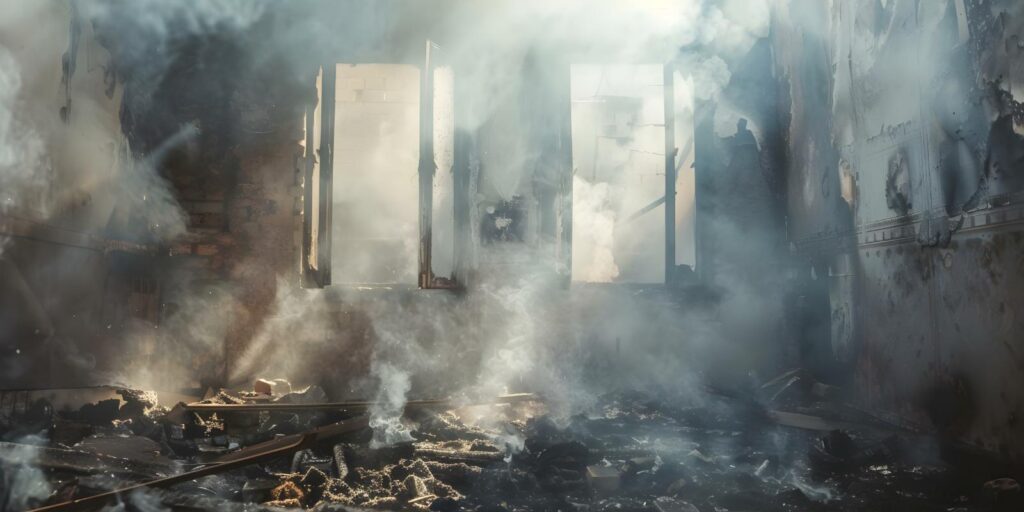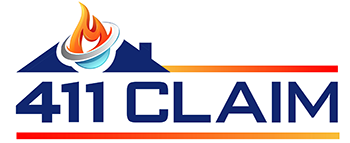
Contents
Imagine your home as a ship caught in a storm, battered but still afloat, waiting for rescue. After a fire, the path to recovery involves meticulously evaluating the fire restoration damage and ensuring safety before any repairs begin. Each step is essential to restoring your space, from water removal to structural repairs. Understanding the process can ease the burden of recovery, but what exactly does it entail, and how can you navigate it effectively?
Key Takeaways
- Conduct a thorough damage evaluation to assess fire and smoke damage, including structural issues and hazardous materials.
- Ensure safety by securing the property, checking for structural instability, and removing debris or hazardous items.
- Remove water and promote drying using pumps, dehumidifiers, and fans to prevent mold growth.
- Perform necessary structural repairs and address lingering odors through deodorization techniques and air filtration.
- Complete a final inspection to verify repairs, ensure safety standards, and prepare for reclaiming the home.
Assessing the Damage
When you first enter a space affected by fire, it’s vital to assess the damage thoroughly to understand the extent of the destruction and identify safety hazards.
Start with a damage evaluation, inspecting walls, ceilings, and floors for charring or structural compromise. Look for smoke damage, which can infiltrate deeper materials, affecting air quality and safety. Document everything meticulously, as this will be important for insurance claims.
Take photos and notes, focusing on affected items and areas that may need restoration. Be mindful of lingering odors or hazardous materials, which could pose health risks.
It’s understandable to feel overwhelmed, but remember, you’re not alone in this process. Reaching out for professional help can ease the burden and facilitate a thorough assessment.
Your home deserves to be restored, and a detailed damage evaluation is the important first step in reclaiming your space and peace of mind.
Ensuring Safety
Before you begin any restoration work, ensuring safety is paramount, as lingering hazards can pose serious risks. You must prioritize fire safety and emergency preparedness to protect yourself and others during this challenging time.
Start by evaluating the environment for potential dangers:
- Check for structural instability: Inspect walls, ceilings, and floors for damage that could lead to collapse.
- Identify hazardous materials: Look for debris, chemicals, or burned items that may release toxic fumes.
- Ensure proper ventilation: Open windows and doors to minimize smoke inhalation and improve air quality.
Taking these precautions not only safeguards your well-being but also enhances the efficiency of your restoration efforts.
Remember, you’re not alone in this process; reaching out to your community for support can make a significant difference.
Contacting Professionals
Although you may feel tempted to tackle fire restoration on your own, contacting professionals is essential for effectively addressing the damage and ensuring safety.
Fire damage often leaves behind hidden hazards, such as structural weaknesses or toxic residues. A qualified restoration team has the expertise to assess the situation thoroughly, ensuring no detail is overlooked.
These professionals use specialized equipment and techniques to mitigate damage and restore your property to its pre-fire condition.
They’ll guide you through the process, alleviating your stress and helping you feel secure in your home again. Their understanding of fire damage restoration means they can identify and resolve issues that mightn’t be immediately apparent to you.
Reaching out to a restoration team isn’t just about fixing your property; it’s about reclaiming your peace of mind.
You don’t have to go through this alone—support is available, and professional help makes all the difference.
Securing the Property
Once the fire is under control, your first priority is to assess any structural damage to guarantee the safety of the property.
Carefully inspecting walls, ceilings, and foundations will help you identify vulnerabilities that could lead to further issues.
Taking immediate steps to prevent additional damage can save you time and resources in the long run.
Assessing Structural Damage
When evaluating structural damage after a fire, it’s important to secure the property immediately to prevent further harm or unauthorized access. This step not only prioritizes fire safety but also sets the stage for thorough damage evaluation.
You’ll want to take into account the following:
- Boarding up windows and doors to deter intruders and protect against weather elements.
- Assessing the integrity of walls and ceilings for signs of weakness or collapse.
- Documenting damage with photos for insurance claims and future reference.
Taking these actions helps you create a safer environment while you gather information for restoration.
Preventing Further Damage
After securing the property and evaluating structural damage, the next priority is preventing further damage to the affected areas.
You’ll want to promptly remove any debris and water to minimize the risk of mold growth. Cover broken windows and doors with tarps or boards to protect against weather elements.
Consider using fire prevention strategies, such as installing fire-resistant barriers, to safeguard your home for the future.
It’s essential to document all damage for insurance claims as you navigate this challenging time.
Remember, emergency preparedness isn’t just about the immediate aftermath; it’s also about planning for the long-term recovery of your space.
You’re not alone in this journey—reaching out for professional help can provide you with the support you need.
Water Removal and Drying
As soon as the fire is extinguished, addressing water removal and drying becomes essential to prevent further damage to your property.
Standing water can lead to mold growth and structural issues, so it’s vital to act quickly. You’ll need to employ effective water extraction methods and drying techniques to restore your space.
Here’s what you should focus on:
- Water Extraction: Use pumps and wet vacuums to remove as much water as possible.
- Dehumidification: Set up dehumidifiers to control humidity levels and speed up drying.
- Air Circulation: Utilize fans to increase airflow, helping to evaporate residual moisture.
Smoke and Soot Cleanup
After a fire, evaluating smoke damage is essential to understanding the extent of the impact on your property.
You’ll need to implement effective soot removal techniques to restore surfaces and prevent lingering odors.
This process can be challenging, but addressing it promptly will help bring your space back to a safe and livable condition.
Assessing Smoke Damage
How can you effectively evaluate the extent of smoke damage in your property? Start by systematically inspecting affected areas and documenting any visible signs. This will help with insurance claims later.
- Check for discolored walls and ceilings, which indicate smoke penetration.
- Assess the air quality; lingering odors can signify deeper damage.
- Use smoke detection tools to identify hidden residues in vents and fabrics.
Understanding the severity of smoke damage is essential for both recovery and ensuring your insurance provider acknowledges the full extent of the loss.
Take your time and approach this assessment with care; your home deserves a thorough evaluation to restore it to its former state.
You’re not alone in this journey—support is available to help you through the process.
Soot Removal Techniques
Effective soot removal is essential for restoring your property after smoke damage, and there are several techniques you can employ.
Start by using a vacuum with a high-efficiency particulate air (HEPA) filter to capture loose soot particles.
For walls and ceilings, consider employing dry cleaning sponges, which can effectively absorb soot without smearing it.
If you encounter stubborn residues, use specialized cleaning solutions designed for soot removal; always test them on a small area first.
You might also want to use a professional-grade fogger to penetrate hard-to-reach areas.
Remember, patience is key—take your time to guarantee thorough cleaning.
Structural Repairs
When a fire ravages your property, addressing structural repairs becomes an essential step in restoring safety and stability. You need to guarantee that the building meets fire code compliance while maintaining its structural integrity.
Begin by evaluating the damage; this will help you identify which areas require immediate attention.
Consider focusing on these key areas during your repairs:
- Load-bearing walls: Check for any cracks or weaknesses that could compromise stability.
- Roof and ceilings: Inspect for sagging or charred materials that need replacement.
- Foundation: Ensure there are no signs of shifting or damage that could lead to further issues.
Engaging with professionals who specialize in fire restoration can provide you with the expertise needed to navigate these repairs.
Odor Removal
Although you might have completed the structural repairs, lingering odors from the fire can still make your space uncomfortable. To reclaim your home, you’ll need to employ effective deodorization methods. Start by identifying the source of the odors, as they often linger in walls, textiles, and air ducts.
Here are some odor neutralization techniques to reflect upon:
| Technique | Description |
|---|---|
| Thermal Fogging | Uses heat to disperse deodorizing agents into affected areas. |
| Ozone Treatment | Generates ozone to neutralize smoke particles and odors. |
| HEPA Air Filtration | Captures airborne particles, improving indoor air quality. |
These methods can notably enhance your environment, allowing you to feel at home again. It’s crucial to address these odors thoroughly; after all, a fresh-smelling space will help restore your sense of belonging and comfort.
Final Inspection and Restoration
As you approach the final stages of fire restoration, conducting a thorough inspection is essential to verify every detail has been addressed. This final walkthrough helps confirm your space isn’t just restored, but revitalized. Use a restoration checklist to guide you through this critical process.
- Verify all repairs are complete and meet safety standards.
- Check for any lingering odors or signs of smoke damage.
- Confirm all affected areas have been properly cleaned and treated.
Taking these steps not only reassures you of the quality of work but also provides peace of mind as you prepare to reclaim your home.
Don’t rush this stage; it’s your opportunity to ensure that everything aligns with your expectations and needs. A careful inspection lays the foundation for your fresh start, fostering a sense of belonging and comfort in your newly restored space.
Recap
In fire restoration, every step is essential to reclaiming your home. You might think that the damage is insurmountable, but with the right approach, it’s entirely possible to restore your space. By understanding the thorough process—assessing damage, ensuring safety, and addressing smoke and odors—you’re not just repairing a house; you’re rebuilding your sanctuary. Remember, seeking professional help can make all the difference, transforming your experience from overwhelming to manageable, paving the way for renewed comfort and peace.
Recent Posts
Pricing Insights for Damage Restoration Services
When unexpected events disrupt your life, steering through the costs of damage restoration can feel
Budgeting for Blaze Cleanup: A Trusty Guide
Budgeting for blaze cleanup is like steering through a maze—complex and overwhelming but attainable with
Top Storm Damage Repair Techniques for Homeowners
When storms release their fury, the aftermath of storm damage can feel overwhelming, much like
